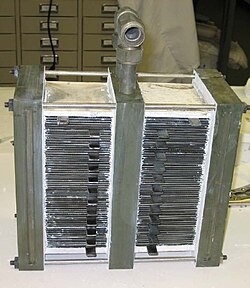
A solid oxide electrolyzer cell (SOEC) is a solid oxide fuel cell that runs in regenerative mode to achieve the electrolysis of water (and/or carbon dioxide)[1] by using a solid oxide, or ceramic, electrolyte to produce hydrogen gas[2] (and/or carbon monoxide) and oxygen. The production of pure hydrogen is compelling because it is a clean fuel that can be stored, making it a potential alternative to batteries, methane, and other energy sources (see hydrogen economy).[3] Electrolysis is currently the most promising method of hydrogen production from water due to high efficiency of conversion and relatively low required energy input when compared to thermochemical and photocatalytic methods.[4]
- ^ Zheng, Yun; Wang, Jianchen; Yu, Bo; Zhang, Wenqiang; Chen, Jing; Qiao, Jinli; Zhang, Jiujun (2017). "A review of high temperature co-electrolysis of H O and CO to produce sustainable fuels using solid oxide electrolysis cells (SOECs): advanced materials and technology". Chem. Soc. Rev. 46 (5): 1427–1463. doi:10.1039/C6CS00403B. PMID 28165079.
- ^ Durability of solid oxide electrolysis cells for hydrogen production Archived 2009-07-11 at the Wayback Machine
- ^ Ni M, Leung MKH, Leung DYC, Sumathy K. A review and recent developments in photocatalytic water-splitting using TiO2 for hydrogen production. Renewable Sustainable Energy Rev 2007;11(3):401–25.
- ^ Ni, M.; Leung, M. K. H.; Leung, D. Y. C. (2008). "Technological development of hydrogen production by solid oxide electrolyzer cell (SOEC)". International Journal of Hydrogen Energy. 33 (9): 2337–2354. doi:10.1016/j.ijhydene.2008.02.048.